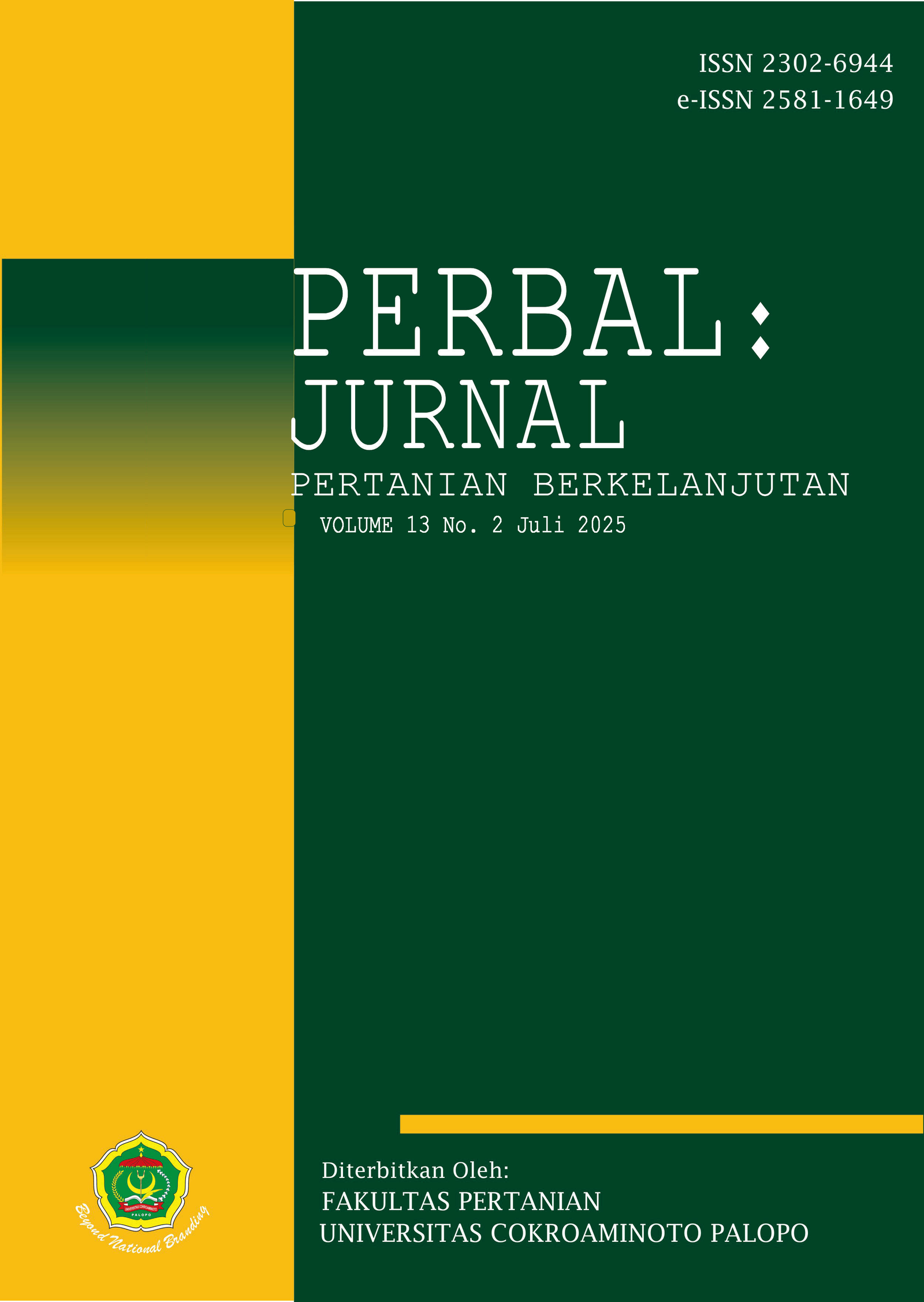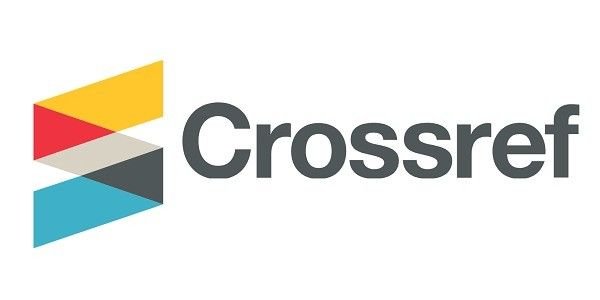Analisis Sifat Kimia dan Fisik pada Media Tanam Tandan Kosong Kelapa Sawit dan Cocopeat
Analysis of Chemical and Physical Properties of Oil Palm Empty Fruit Bunches and Cocopeat Planting Media
DOI:
https://doi.org/10.30605/perbal.v13i2.6356Keywords:
Tandan kosong kelapa sawit (TKKS), cocopeat, media tanam alternatif, limbah organik, pertanian berkelanjutanAbstract
Ketersediaan media tanam yang ramah lingkungan dan berbasis limbah organik menjadi isu penting dalam mendukung praktik pertanian berkelanjutan di tengah menurunnya kualitas tanah dan meningkatnya penggunaan bahan kimia dalam budidaya pertanian. Salah satu upaya yang dapat diflakukan adalah memanfaatkan limbah pertanian dan perkebunan sebagai media tanam alternatif. Penelitian ini bertujuan untuk menganalisis sifat kimia dan fisik dari dua jenis bahan organik, yaitu tandan kosong kelapa sawit (TKKS) dan cocopeat, untuk mengetahui kelayakannya sebagai media tanam alternatif. Metode yang digunakan meliputi analisis laboratorium terhadap parameter kimia seperti kandungan karbon organik (C-organik), nitrogen total (N-total), fosfat (P₂O₅), kalium (K₂O), kalsium oksida (CaO), magnesium oksida (MgO), serta unsur mikro seperti seng (Zn) dan tembaga (Cu). Selain itu, dilakukan pengujian parameter fisik seperti kadar air dan porositas, serta kandungan logam berat timbal (Pb) untuk menilai aspek keamanan lingkungan. Hasil penelitian menunjukkan bahwa TKKS memiliki kandungan unsur hara makro yang tinggi, yaitu C-organik 28,47%, N-total 1,52%, P₂O₅ 1,49%, dan K₂O 10,90%, yang sangat potensial dalam mendukung pertumbuhan tanaman. Di sisi lain, cocopeat memiliki keunggulan pada karakteristik fisik, seperti kadar air dan porositas yang tinggi, serta kandungan C-organik sebesar 24,55% dan N-total 0,63%. Analisis logam berat menunjukkan bahwa kedua media tidak mengandung Pb sehingga aman digunakan. Berdasarkan hasil tersebut, TKKS dan cocopeat dapat direkomendasikan sebagai media tanam alternatif yang tidak hanya bernilai agronomis, tetapi juga berkontribusi dalam pengurangan limbah organik dan pencemaran lingkungan, sekaligus mendukung pembangunan pertanian yang berkelanjutan.
The availability of environmentally friendly growing media based on organic waste has become a critical issue in supporting sustainable agricultural practices, especially amid declining soil quality and increasing use of chemical inputs in crop cultivation. One potential strategy to address this challenge is the utilization of agricultural and plantation waste as an alternative growing medium. This study aims to analyze the chemical and physical properties of two types of organic materials—oil palm empty fruit bunches (EFB) and cocopeat—to evaluate their suitability as alternative growing media. The method employed includes laboratory analysis of chemical parameters such as organic carbon (C-organic), total nitrogen (N-total), phosphate (P₂O₅), potassium (K₂O), calcium oxide (CaO), magnesium oxide (MgO), and micronutrients such as zinc (Zn) and copper (Cu). In addition, physical parameters such as moisture content and porosity, as well as the presence of heavy metal lead (Pb), were examined to assess environmental safety. The results showed that EFB contains high levels of macronutrients, with 28.47% C-organic, 1.52% N-total, 1.49% P₂O₅, and 10.90% K₂O, indicating its strong potential to support plant growth. On the other hand, cocopeat exhibited superior physical properties, including high moisture content and porosity, along with 24.55% C-organic and 0.63% N-total. Heavy metal analysis revealed that both media were free from Pb contamination, making them safe for use. Based on these findings, EFB and cocopeat are recommended as alternative growing media that are not only agronomically beneficial but also contribute to reducing organic waste and environmental pollution, thereby supporting the advancement of sustainable agriculture.
Downloads
References
Altsazani, F., & Silvina, F. (2024). aplikasi kompos tkks dan tinggi pembumbunan terhadap pertumbuhan dan produksi kacang tanah (Arachis hypogaea L.). Jurnal Penelitian Ilmiah Multidisiplin, 8(8). DOI: https://doi.org/10.25181/jppt.v24i1.2980
Amelya, A.Y.S., & Syarovy, M. (2024). Pemanfaatan berbagai jenis bahan pembenah tanah pada pembibitan kelapa sawit (Elaeis guineensis Jacq.). WARTA Pusat Penelitian Kelapa Sawit, 29(3), 197-207. DOI: https://doi.org/10.22302/iopri.war.warta.v29i3.131
Blok, C., Beerling, E., Barbagli, T., & Eveleens, B. (2024). Renewable raw materials for growing media: Basic data for the environmental impact of potting soil and substrates agreement. (Report/ Stichting Wageningen Research, Wageningen Plant Research, Business Unit Greenhouse Horticulture, No. WPR-1354). Wageningen Plant Research. https://doi.org/10.18174/673902. DOI: https://doi.org/10.18174/673902
Fadilah, D.R., Wulandari, R., & Syahputra, G. R. (2025). Effect of growing media composition and watering intervals on the growth of Gmelina arborea Roxb seedlings. Jurnal Penelitian Pendidikan IPA, 11(1), 446-455. DOI: https://doi.org/10.29303/jppipa.v11i1.9963
Herwibowo, K., & Budiana, N.S. (2021). Hidroponik Bertanam Sayur Tanpa Tanah. Penebar Swadaya Grup.
Huber, D.M., & Jones, J.B. (2013). The role of magnesium in plant disease. Plant and Soil, 368, 73-85. DOI: https://doi.org/10.1007/s11104-012-1476-0
Koul, B., Yakoob, M., & Shah, M.P. (2022). Agricultural waste management strategies for environmental sustainability. Environmental Research, 206, 112285. DOI: https://doi.org/10.1016/j.envres.2021.112285
Mansyur, N.I., Pudjiwati, E.H., & Murtilaksono, A. (2021). Pupuk dan Pemupukan. Syiah Kuala University Press. DOI: https://doi.org/10.52574/syiahkualauniversitypress.379
Nazara, R.V., Telaumbanua, P.H., Harefa, K.S. E., Daeli, D.E.J., & Sole, R.A. (2024). Efektivitas lama pemberian nutrisi terhadap produktivitas pakcoy (Brassica rapa L.) pada media tumbuh organik secara hidroponik sistem NFT (Nutrient Film Technique). AGRIUM: Jurnal Ilmu Pertanian, 27(2), 212-223.
Nontji, M., Galib, M., Amran, F.D., & Suryanti, S. (2022). Pemanfaatan sabut kelapa menjadi cocopeat dalam upaya peningkatan ekonomi masyarakat. JPPM (Jurnal Pengabdian dan Pemberdayaan Masyarakat), 6(1), 145-152. DOI: https://doi.org/10.30595/jppm.v6i1.7581
Nurhadianty, V., Cahyani, C., Nirwana, W.O.C., & Dewi, L.K. (2018). Pengantar Teknologi Fermentasi Skala Industri. Universitas Brawijaya Press.
Purnama, R.R., Chumaidi, A., & Saleh, A. (2012). Pemanfaatan limbah cair CPO sebagai perekat pada pembuatan briket dari arang tandan kosong kelapa sawit. Jurnal Teknik Kimia, 18(3).
Ramince, R., & Zubaidah, S. (2015). Peningkatan pertumbuhan dan hasil cabai besar (Capsicum annum L.) melalui pemberian kompos tandan kosong kelapa sawit dan pupuk hayati pada tanah podsolik. AgriPeat, 16(01), 20-27.
Siswanto, T., & Rosmawaty, T. (2022). Uji aplikasi bokashi daun ketapang dan NPK 16: 16: 16 terhadap pertumbuhan bibit jabon putih (Antocephalus cadamba). Jurnal Agroteknologi Agribisnis dan Akuakultur, 2(1), 1-12.
Sipayung, P., Hutauruk, S., Purba, A.H., & Sidauruk, L. (2023). Respon pertumbuhan dan produksi kedelai hitam malika (Glycine soja, L.) terhadap media tanam cocopeat-topsoil dan pupuk fosfor. Jurnal METHODAGRO, 9(1), 57-65.
Sodiq, A.H., Sheren, K.D., Fatmawaty, A.A., & Susiyanti, S. (2023). The effect of dosing potash fertilizer and compost doses of empty bunches of oil palm (tkks) on the growth of citronella plants (Cymbopogon nardus L.). JERAMI: Indonesian Journal of Crop Science, 5(2), 41-55. DOI: https://doi.org/10.25077/jijcs.5.2.1-15.2023
Supadma, A.N., Mega, I.M., & Dana, I.M. (2019). Kajian kualitas beberapa pupuk kompos produksi simantri di daerah bali sesuai dengan standar nasional Indonesia Tahun 2004 (SNI 19-7030-2004). Agrotrop: Journal on Agriculture Science, 8(2), 121. DOI: https://doi.org/10.24843/AJoAS.2018.v08.i02.p02
Trisakti, B., Mhardela, P., Husaini, T., & Daimon, H. (2018,). Production of oil palm empty fruit bunch compost for ornamental plant cultivation. IOP Conference Series: Materials Science and Engineering. 309(1), 012094). IOP Publishing. DOI: https://doi.org/10.1088/1757-899X/309/1/012094
Tyasmoro, S.Y. (2023). Pertanian Organik: Penerapan Pupuk Organik Menuju Pertanian Berkelanjutan. Universitas Brawijaya Press. DOI: https://doi.org/10.11594/ubpress9786232966772
Wahdah, R. (2023). The effect of composted oil palm empty bunches on growth and yield of pakchoi plants in ultisol soil. Tropical Wetland Journal, 9(2), 20-28. DOI: https://doi.org/10.20527/twj.v9i2.124
Downloads
Published
Issue
Section
License
Copyright (c) 2025 Habilla Lubis, Suratni Afrianti

This work is licensed under a Creative Commons Attribution 4.0 International License.
In submitting the manuscript to the journal, the authors certify that:
- They are authorized by their co-authors to enter into these arrangements.
- The work described has not been formally published before, except in the form of an abstract or as part of a published lecture, review, thesis, or overlay journal.
- That it is not under consideration for publication elsewhere,
- That its publication has been approved by all the author(s) and by the responsible authorities – tacitly or explicitly – of the institutes where the work has been carried out.
- They secure the right to reproduce any material that has already been published or copyrighted elsewhere.
- They agree to the following license and copyright agreement.
License and Copyright Agreement
Authors who publish with Onoma Journal: Education, Languages??, and Literature agree to the following terms:
- Authors retain copyright and grant the journal right of first publication with the work simultaneously licensed under Creative Commons Attribution License (CC BY 4.0) that allows others to share the work with an acknowledgment of the work's authorship and initial publication in this journal.
- Authors are able to enter into separate, additional contractual arrangements for the non-exclusive distribution of the journal's published version of the work (e.g., post it to an institutional repository or publish it in a book), with an acknowledgment of its initial publication in this journal.
- Authors are permitted and encouraged to post their work online (e.g., in institutional repositories or on their website) prior to and during the submission process, as it can lead to productive exchanges, as well as earlier and greater citation of published work.














